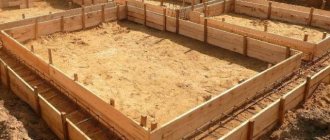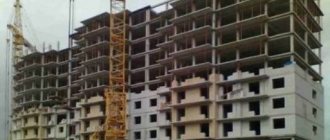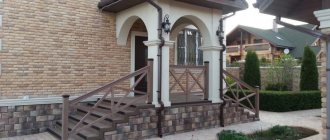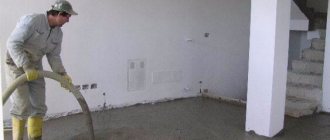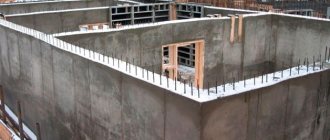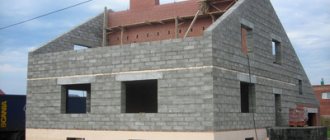They help not only to strengthen the existing slope, but also to create zoning, terracing and decoration of the area.
One of the functions of a concrete retaining wall is to protect foundations from ground movement.
To fill the wall, concrete of certain grades is used, and before performing work, it is necessary to calculate the dimensions and amount of material for the wall.
What it is?
The retaining wall is located in suburban and urban areas where there is complex terrain. If there are hills or ravines in the area, which create problems for creating a normal garden and arranging a beautiful yard, they decide to fill retaining walls.
In this case, the site is divided into several zones, terraces are made, where the wall plays a key role. Terraces are artificially strengthened with such structures; owners have the opportunity to decorate the yard as they wish without taking into account problems with the slope.
The retaining wall performs the following functions:
- zoning of the territory;
- addition of landscape design;
- keeping soil from washing away;
- water redirection;
- in areas with slopes, creating an obstacle to soil erosion.
A retaining wall decorates the garden and can protect the alleys from destruction. In landscape design, it can be used as a large pot for planting plants. The main role of such a structure is to protect foundations and areas from soil erosion and sliding.
Despite the fact that to prevent the soil from sliding, it is enough to plant plants - their roots will hold the soil, a wall is still necessary.
Over time, insects settle in the roots of plants and trees, which can easily destroy a healthy root system and cause the earth to slide down.
This design is especially important in areas with a slope, where it is difficult to predict the collapse of the earth. The walls are erected from concrete and other materials, lined with finishing to taste. The result is a beautiful and functional element of the exterior.
Specifications
Concrete is characterized by good resistance to compression, but insufficient resistance to tension. A metal frame made of monolithic reinforced concrete is designed to neutralize this property, which, in turn, shows excellent results in tension, but insufficient results in compression. The combination of both materials allows you to take advantage of only their advantages during construction.
The remaining characteristics of structures are determined by the type of concrete.
- Lightweight concrete - expanded clay concrete, sawdust concrete, etc., are used for lightweight structures and to reduce thermal conductivity, since in these indicators concrete is inferior to clay brick.
- Heavy concrete - with a density of 2200–2500 kg/cubic meter ensures the reliability of load-bearing structures and foundations. The mixture is selected according to cash registers - B1, B2, B1.5.
A variety of additional components are introduced into the composition of concrete to obtain certain properties. Thus, the same sawdust in the composition of the corresponding brand increases the thermal insulation qualities, and the addition of rocks increases strength.
Now let's talk about the thermal conductivity of monolithic reinforced concrete. The thermal conductivity of the stone depends on the filler.
- Monolithic concrete without additives has the maximum thermal conductivity - 1.75 W/(m deg).
- The performance of the mixture with the addition of crushed stone and gravel is slightly better - 1.51 W/(m deg).
- The indicators of the material on sand, slag and with the addition of silicates range from 0.3 to .81 W/(m deg).
- Special thermal insulation concrete has the maximum thermal insulation characteristics - 0.18 W/(m deg), as well as a mixture based on volcanic slag - 0.2–0.5 W/(m deg), which corresponds to the performance of ceramic slotted and hollow bricks.
The design solution of monolithic reinforced concrete is regulated by GOST and the relevant SNiP requirements. The documents indicate possible schemes and those products that can be used for the construction of certain elements. According to GOST, the load-bearing system of a building must be a single whole consisting of a foundation, vertical supports - walls and columns, and horizontal slabs - floors and coverings.
It is worth noting that the slabs, in fact, are already elements of prefabricated monolithic construction. However, in the documentation they are also called monolithic structures.
Why is it necessary to obtain monolithic reinforced concrete, what is its scope, read on.
Design Features
According to its design, a retaining wall can be either solid or simple. In the first case, the wall has a foundation; it is made of mortar. Simple structures are laid out without mortar, using stone.
A massive main wall will have a lot of weight and even extensive soil sliding will not be able to move it. If the wall has a small thickness, then soil is used during the arrangement, which creates forces directed in the opposite direction to overturn the earth.
A permanent retaining wall is also made using reinforcement, and a thin-walled one involves excavation work. If the budget is small, then corner structures with a cantilever are erected: such retaining walls serve as an excellent place for planting plants.
Low retaining walls, 30-80 cm high, are more used as decorative ones. They are made in the form of a trapezoid or parallelepiped. When the soil swells, they will not budge. If the height of the wall is low, then the foundation for it is not poured, and the fertile layer is replaced with non-metallic material. If the height is greater, then the lower part is recessed 30 cm down.
If the height difference is 1 meter, in areas with a slope medium-height walls are made. The structure is expanded at the bottom using a heel, and the wall itself is poured with concrete in place. If the height of the retaining wall is average, drainage from polymer pipes must be used.
For high walls, make a small thickness, using soil in parallel to create resistance.
Factors affecting the stability of a supporting wall
The calculation of a retaining wall, which can be done online, should also be carried out in order to determine factors that may affect the stability of the structure. Among the most frequently mentioned factors are:
- vibration strength;
- actions of groundwater;
- seismic impacts;
- stability depending on thickness;
- climatic features of the region.
The stability is affected by the correct determination of thickness. In this case, it is important that the soil has the appropriate characteristics and that the height of the structure is not too high. If the site has soft soil, then the width of the support should be greater. But at a height of more than 2 m, wind load should also be taken into account.
What brand of material is suitable for filling?
To pour a concrete wall, you need to choose the right material. Most often, M200 grade concrete is used for this purpose.
Several characteristics of concrete that meet the requirements for supporting wall materials:
- belongs to class b15;
- moisture resistance from w2 to w6: during hardening it is able to withstand a water column pressure of 0.6 atm;
- density 2200-2400 kg per cubic meter;
- fast hardening;
- compressive strength – 196 kg/cm. sq.;
- withstands loads up to 20 MPa/m3;
- mobility from P2 to P4;
- frost resistance F100.
Concrete M200 has low thermal conductivity and is highly resistant to adverse and aggressive weather conditions. Used for civil and industrial construction, the solution obtained from it is strong and reliable.
Pros and cons of use
In most cases, retaining walls are made of concrete, but sometimes wood, natural stone or brick are used instead.
A few reasons why concrete is still better suited for this purpose:
- choice;
- strength;
- resistance;
- simplicity;
- flexibility;
- good appearance;
- environmental friendliness.
When choosing concrete, the site owner has the opportunity to independently decide what type of structure will be used.
Concrete blocks, precast concrete panels, and on-site concrete casting are equally suitable for this purpose This material is so strong that it can withstand tons of soil and water. Every year the finished retaining wall will only gain strength.
Such walls are durable and resistant to repeated cycles of defrosting and freezing; they are not afraid of aggressive chemical elements and road salts.
Concrete walls are easy to create; with their help you can easily create curves, corners and even stairs, thereby diversifying your site. Concrete can be finished with a variety of materials and is easy to maintain. It does not emit harmful substances and is available for construction.
There are several cons that vote against the use of concrete:
- Firstly, this requires careful planning and design, which not every site owner can do.
- Secondly, this is the complexity of the work, which should only be performed by qualified craftsmen.
- Thirdly, such walls are difficult to dismantle, and it may be necessary if there is a desire to redo the design.
Body
The body is the above-ground component of the support. Its main functions:
- Ensure stability - due to the mass of the structure itself and the earth;
- Decorative – should provide a pleasant visual perception;
It is also necessary to distinguish different types of body fastening: rigid structure (monolithic concrete blocks, brickwork) and elastic (materials that can withstand minor deformation without destruction).
Based on the design parameters, it is necessary to determine the need for tilt. If the wall height does not exceed 1.5 meters, then, as a rule, a slope is not required. If the specified value is exceeded, a slight slope will improve its visual perception.
How to make a calculation?
In order for the structure to fully fulfill its function, at the planning stage it is necessary to calculate its dimensions: thickness and other indicators.
There are SNiP requirements that should be adhered to during calculations:
at 60 cm the wall should be minimally buried in the ground;- from the height of the entire wall, its width should be within 50-70 cm to start calculations;
- the wall should be recessed towards the elevation by 12.5 cm for each linear meter;
- The top cut for a solid wall should be at least 40 cm.
According to the regulations, it is necessary to choose the type of drainage: longitudinal, transverse or combined. For example, if the level of height difference in the area is 130 cm, then the height of the wall according to the standards should be about 2 meters with dimensions for deepening. The calculations also take into account the type of soil, namely the value of its specific adhesion.
Retaining wall drawings:
Determining the angle of the rear wall:
tg e = (bt)/h – calculation of the maximum angle of inclination,
Where
e – angle of inclination of the surface to the vertical (no more than 45-j/2); b – foundation width; t – wall thickness; h – height from the base of the foundation to the ground; j – angle of internal friction.
You can also use standard values of degrees of slope: for sandy soils 36 - 43; sandy loam 18-30; loams 12-24; clayey 11-18.
Materials and tools for self-construction
When the calculations are completed, you can begin to prepare materials and tools.
To build reinforced concrete walls yourself you will need:
- concrete mixer;
- wooden beam;
- buckets;
- water;
- nails;
- a simple pencil;
- expanded clay;
- shovel;
- Master OK;
- roulette;
- building level;
- cement grade M200 or class b
You will also need reinforcement to strengthen the walls. To create formwork for pouring, wooden boards will be useful, which will need to be placed around the perimeter of the future retaining wall and then filled with concrete.
Expanded clay is used for drainage, but if this material is difficult to obtain, crushed stone and gravel can be used instead. Nails will help securely secure the formwork with boards, and if there is a risk of it bending from the concrete, then you can use metal corners.
Dismantling of formwork
After the concrete solution has hardened and achieved its maximum strength characteristics, they begin to dismantle the formwork. Removal of formwork is entrusted to qualified workers. Dismantling begins with removing the side parts of the formwork, which do not bear the load on the structure
It is important to dismantle the formwork after ensuring the strength of the concrete, which is established by building codes. Determine the strength of concrete mortar in the laboratory by conducting trial tests on samples of the material
Stripping is carried out in a strict sequence, ensuring the safety of structural elements.
Description of the technology for pouring a support structure with your own hands step by step
The technology for creating a retaining wall begins with digging a trench . To do this, you can order an excavator or do everything manually using shovels. The trench is leveled using shovels.
Wall reinforcement
To strengthen a retaining wall when it is thick and high, reinforcement is used.
For this, metal rods and rods are used. After a layer of crushed stone or expanded clay, reinforced mesh or rods are laid at the bottom of the trench - this gives the foundation strength.
The rods are placed vertically along the entire contour of the ditch . Thick rods are installed vertically, then thin wire is welded to them horizontally.
The result is lattices that are connected by bridges with a thickness less than the thickness of the thickest reinforcement in the structure.
Creating formwork
At the next stage, formwork is created. For this, wooden boards with a thickness of at least 3 cm are used. To connect the boards, wooden blocks with a cross section of 5x10 cm are used.
To fix the formwork, metal pins are used: they are driven into the ground in increments of no more than 50 cm. The formwork begins to be built from the back wall, then the rest of the structure is made.
Creating drainage and other actions
Drainage is made of moisture-absorbing materials. To do this, you need to make a hole with a diameter of 10 cm in the retaining wall and place a polymer tube there that will remove moisture.
Next, mix the solution in the following proportions:
- cement 1 part;
- sand 3 parts;
- fine crushed stone 1 part;
- water 1 part.
Concrete is poured after installing the reinforcing belt along the entire length of the formwork. Cured concrete is periodically moistened with water to prevent cracking. At the final stage, waterproofing is carried out using roofing felt or roofing felt.
Main stages of construction
You can equip a simple design with your own hands without paying for the services of professionals. It is enough to correctly make the calculations and apply the markings, guided by the plan. At the dacha, every centimeter of area matters, so there is an already developed algorithm of actions:
- They dig a trench, strictly following the markings, focusing on the thickness of the purchased blocks (width) and a depth of about a quarter of a meter;
- to start installation, make a base of gravel (at least 10 cm from the height of the wall), then thoroughly compact it and apply a layer of cement;
- hollow cells are filled for greater strength;
- a canopy will be installed over the last row to minimize the likely consequences of destructive natural factors.
When building a decorative structure, one row of blocks is enough, but if you need to prevent a large mass of soil from sliding, it is better to lay out two rows, equip an earthen rampart on the inside and a drainage system. It will reduce the likelihood of destruction from rain and prevent cracks from freezing if water gets inside the blocks used for construction.
How to make a retaining wall from blocks, watch the video.
Features of device technology on a site with a slope
If the site contains a slope, then the technique will be similar, but at the planning stage you will have to worry about the size and terracing of the site. The owner will have to divide the area into several horizontal zones, and also hire equipment to dig a trench for retaining walls.
A gentle slope can be strengthened with the help of plant roots, but if the slope has a good difference in height, then the construction of a concrete wall cannot be avoided.
For formwork, it is better to use OSB boards, since you will have to bury the base of the wall into the ground as much as possible. Drainage must also be effective: polymer or asbestos-cement pipes are used for its installation. It is better to do transverse drainage with drainage.
Foundation
Foundation parameters are based on the following factors:
- support dimensions;
- soil type;
- the depth of its freezing;
- presence of flowing groundwater. Based on the depth of the foundation, a distinction is made between shallow and deep (exceeds the width of the base by 1.5 or more times) foundation.
In practice, 2 types of foundations are used: strip and pile . The tape is a solid block that follows the line of the wall and is laid at a depth of at least 60 cm.
When calculating the depth of laying this type of foundation, the depth of soil freezing should be taken into account.
The pile type is more reliable and stable; it is used in cases where the retaining wall is laid on loose soil, or where groundwater flows underneath it at the site of its construction. Piles make it possible to deepen the foundation by several meters or more, giving the entire structure the necessary stability and reliability.
Possible difficulties and errors
If technology is not followed, retaining walls may collapse if the master makes a mistake.
The most common problems:
- insufficient foundation depth;
- poor drainage;
- failure to comply with the rules for resting a wall on a hill;
- the height and weight of the wall are too high;
- construction on soft soils with close water levels.
As a result of these errors, the walls may collapse, become covered with cracks, and also collapse at the bottom. If there is not enough experience in construction and calculations, then it is better to invite a team of specialists.
Stone selection
In the garden landscape, one of the most preferred solutions is traditionally a wall made of natural stone. It immediately creates a feeling of beauty and solidity - something that all other materials are somewhat less capable of. Natural material combines perfectly with any plants that are usually grown on plots. Most often we are talking about:
- granite;
- limestone;
- basalt;
- sandstone.
Sandstone, that is, a combination of quartzite and carbonate, is not very strong due to the presence of iron ore. However, its beauty is undeniable, and for many this becomes a decisive factor.
First of all, the walls are made of rubble stone. They are quite massive and require a special, carefully designed connection to the hill. It is recommended to use geotextiles to cover the strips exactly at the seams. The larger the rubble stone specimens, the better suited they are for the initial tiers. At higher levels, lighter elements can be used.
Sometimes artificial stone is also used for work. It can be done on:
- cement-sand;
- plaster;
- quartz based.
Solutions made from wild chopped material are very popular. It varies in surface shape and attachment methods. But it is worth understanding that split blocks vary greatly in size and geometry, even within a specific batch. Therefore, it is very difficult to use them for installing walls, and only trained professionals can perform such work. In some cases, various types of river stone are also used.
This is about:
- sandstone;
- pebbles;
- limestone.
Price for pouring work
The total cost of pouring a concrete retaining wall varies according to the regions of Russia:
- In Moscow, for such work they will ask for 3,500 rubles per linear meter, while 1,500 rubles will have to be paid for arranging the foundation of the wall.
- In Novosibirsk, they charge from 5,500 rubles for a wall up to 100 cm, while another 1,500 rubles will be charged for digging a trench.
- In Krasnodar, turnkey work will cost from 5,940 rubles per linear meter.
Purpose
If the slope of the land is more than 80º, a protective wall must be erected to prevent soil sliding. The building structure is also installed when placing a private house near a reservoir on a steep bank.
The main functions performed by cement-sand support:
- fixing and securing the soil in the required position;
- zoning of a personal plot;
- formation of horizontal planes in the design of landscape design of the territory.
A support installed on a suburban area performs protective, decorative, or both functions at the same time.
Concrete supports can be equipped with stairs, steps, walkways, etc.
Decor
Concrete bases are not aesthetically pleasing; they have a porous surface that can absorb moisture. Because of this, additional finishing will be required. For this purpose the following means are prepared:
- dye. It is recommended to focus on waterproof products that are designed for rough surfaces;
- tile. It is necessary for external processing;
- wood panels.
When choosing a decorative material, you should take into account the architectural characteristics of buildings and the landscape features of the summer cottage. Finishing costs depend on the products chosen.
Content
- A little theory from the “boring” strength of materials.
- Preparatory work. Choosing: steel or composite?
- Let's find out the differences between working and installation fittings.
- Secrets of the reinforcement “skeleton”.
- How to choose the right reinforcing bars?
- Two-step reinforcement of a monolithic structure.
- Step one. Sole reinforcement.
- Step two. Wall reinforcement.
- Useful tips and recommendations for reinforcement.
Drainage
The drainage layer is used to remove water from the supporting structure, as well as to prevent soil from being washed away. It can be transverse, longitudinal or combined. For subsequent regular removal of water, it is installed at an angle. The pitch of the drainage layer is kept at 1 m. In parallel with the laying of the protective system, a pipe lined with geotextile is installed. This material is able to absorb moisture and remove excess liquid outside the building.




